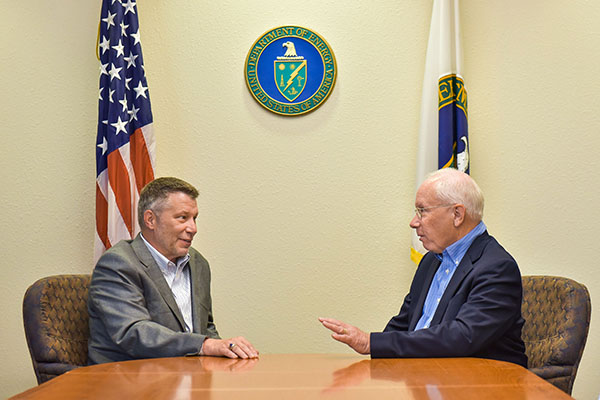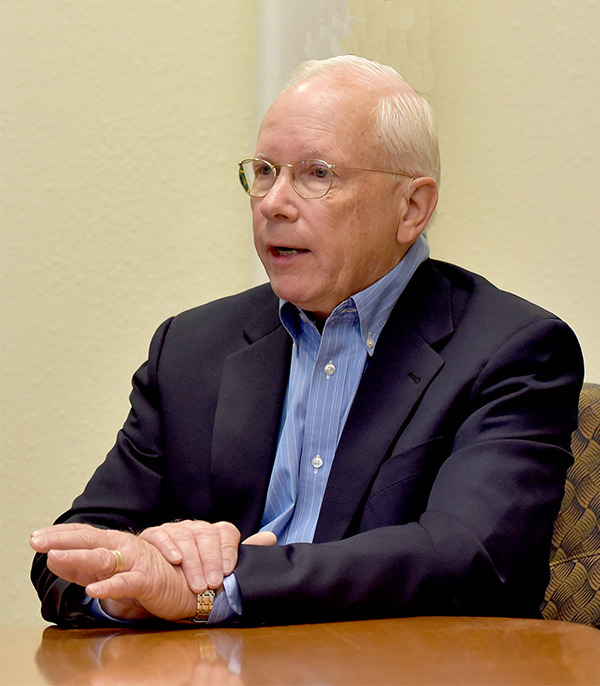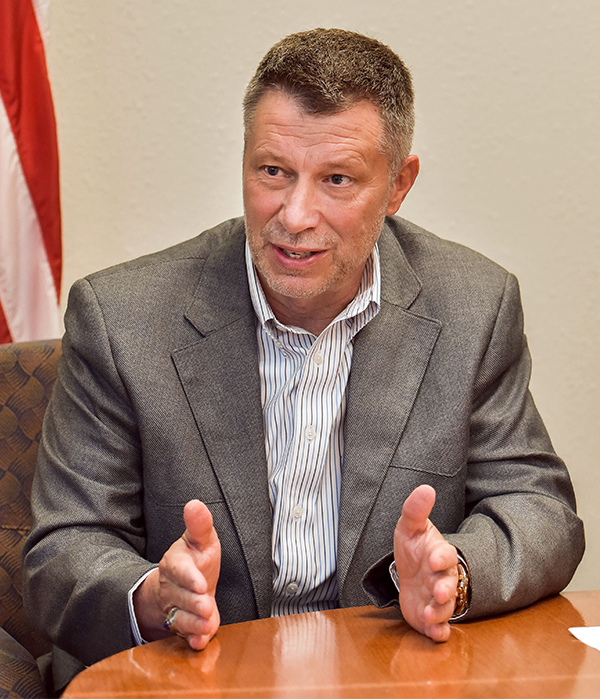A conversation with NNSA Sandia Field Office Manager Jeff Harrell, Sandia Labs Director Steve Younger
In late April, just before National Technology & Engineering Solutions of Sandia — NTESS — assumed management of Sandia for DOE/NNSA, soon-to-be Labs Director Steve Younger and NNSA Sandia Field Office Manager Jeff Harrell sat down with the Lab News to share their thoughts about the relationship between the Labs and NNSA, Sandia’s unique mission, its strengths, and its importance to the nation’s security. The two leaders identified some pressing concerns that need to be addressed over the next few years. Lab News editor Bill Murphy conducted the interview in Harrell’s office.
Lab News: Thanks for sitting down with us today. To start things off, let me ask: How do you envision the relationship between NNSA and Sandia developing over the next few years?
Jeff Harrell: The relationship with the Laboratories and the Labs leadership is excellent, both at the NNSA headquarters and here in the Field Office. So when you say “developing,” I’m not sure I would say we need to develop, which would almost suggest there’s something we need to fix. I think we’ll continue to build on the positives and the very good relationship that we already have.
Steve Younger: I see this as a true partnership, building on the past. We provide goods and services to the government with a national security focus. We’re expected to do that efficiently and we will work with the Field Office to provide the data it needs to assess our performance and ensure we’re carrying out the mission in a safe and secure manner.

LN: Jeff, you mention building on the positives in this relationship. In what way?
JH: One of the things that we’ve seen, especially in just the past several years, is an increased effort in transparency. After talking to Steve about this at length, I think we share the vision that transparency is something we’ll continue to improve — not that there’s a problem, in fact it’s very strong, but it will get better.
SY: As Jeff said, there’s already a strong relationship between the Laboratories and the Field Office. In building on that, I would note that I’m a big believer in data-driven management; that is, show me the numbers, prove that you are performing up to expectations or exceeding expectations. We would like to move a little more in that direction, data-driven management.
LN: Across the board?
SY: Across the board — particularly on the support side of the Laboratories, but also on the technical.

LN: Clearly, Sandia and NNSA are of one mind about where the focus of the Laboratories should be, and that is on the mission. Given that, what factors do you see as helping to ensure mission success?
SY: Mission success rests on a foundation of what I call the enabling functions, which include Finance, Human Resources, Procurement, and Safety and Security. If you get those things right the efficiency of mission delivery only increases.
JH: I completely agree and I’ll add that our motto in NNSA is “Mission First, People Always.” I think that is always going to be a key piece of mission success — taking care of the people.
LN: Steve, as someone who’s been around the weapons complex a long time, have you ever seen situations where the lack of focus on safety or security got in the way of mission success?
SY: Several examples come immediately to mind. Not paying attention to safety and security can have serious consequences for the well-being of your people and for the mission. Y-12 National Security Complex in Oak Ridge had a security problem, Los Alamos National Laboratory had safety issues in their plutonium facility and elsewhere; both caused significant impacts on mission. And that, of course, impacts national security. Safety and security are both every day, every hour efforts.
An investment in the future
LN: Jeff, we know safety and security are extremely important issues, priority issues, for NNSA. Does NNSA see a continued investment in a strong technical basis at the Laboratory to be a high priority, too?
JH: Absolutely, and that ties back to mission. Without a robust technical basis you really can’t advance the mission. Any investment in the technical basis is an investment in the future and that is absolutely essential.
LN: Speaking of investments, NNSA Administrator Lt. Gen. Frank Klotz and others have talked about the need to modernize a lot of the infrastructure across the nuclear weapons enterprise. Is that a concern here at Sandia?
JH: Oh, it’s definitely a concern across the entire enterprise. Fortunately for Sandia — and Steve and I have talked about this — the situation here isn’t as urgent as it is at some of the other NNSA sites. That doesn’t mean it doesn’t need attention here. It is something that NNSA and DOE are looking at right now. I think you’ll see even more emphasis on this issue going forward.
LN: I’m going to shift gears a little bit and talk about Sandia employees. Steve, you’ve noted that you’ve been coming to Sandia and working with Sandians for a long time. Is there anything special you’ve noted about Sandia, about Sandia employees, that you’ve picked up over the years?
SY: As a matter of fact, there is something special about Sandia. The climate in which national security laboratories operate has changed over the past several decades. There was a time when industrial concerns, the big aerospace companies, for example, had large R&D efforts, when the military services had large R&D laboratories. Those efforts have decreased over time. And that leaves Sandia as the dominant national security R&D laboratory. That is a critical mission for the nation. Fortunately, Sandia has a long tradition of collaboration, both within the Laboratories and between the Labs and other national security entities, that has served the country well.
JH: What strikes me as making Sandia, as a laboratory, different, is the breadth of the work done here — it’s amazing. This month marks two years that I’ve been at the Sandia Field Office and I still learn something new every day about work being done at Sandia. So I think that diverse scope of work is one big differentiating factor. And while I can’t speak for all of NNSA, I’d say the relationship between the Field Office here and the Laboratories is the strongest I’ve seen personally and I think that does make it somewhat special, at least in my eyes.
There have been several times just in the past month where people I don’t even know stop me in the hallway and say, “I just want you to know I appreciate the relationship that your office —the field office — has with us in our workplace.” I think that’s very positive, an affirmation of our great relationship.
LN: Again talking about Sandia employees, over the years we’ve prided ourselves on hiring the best and brightest technical staff, going the extra mile to find the best people to come here and help contribute. How important is it that we put that kind of rigor into hiring our support staff?
SY: I strongly believe it’s equally important. Things happen because of a combination of three things: people, places, and processes. Nothing happens unless someone does it; it all happens in some facility, be it an office, a laboratory, or production facility; and processes enable those things to happen.
So they are not just the foundation; the processes are the lubricants that make everything else happen. So, yes, hiring talented people, giving them the training that they need, giving them the facilities that they need, is equally important across the Laboratories.
‘Exceptional service in the national interest’
LN: Let’s move on and talk in broad strokes about the Labs’ culture. Sandia has a legacy of exceptional service in the national interest that goes back 70 years. How do you see the new senior leadership team as building on that legacy?
SY: We embrace that theme of exceptional service in the national interest; it’s rare that the president of the United States gives you a theme that strong and that enduring, so I’ll just leave it at that: We embrace that theme.
LN: Sandians have taken that concept of “exceptional service” and applied it at the community level as well. Is that going to continue to be an emphasis during your tenure?
SY: It’ll certainly continue under our tenure. I’ve been a proud New Mexican for decades. New Mexico is a state rich in culture and diversity. However, there are issues involving education, involving employment, where I think we can make a difference. We would like to help the city and the state address those issues to the extent that’s possible within our contract with DOE and NNSA.
LN: Steve, looking out five years from now, what would you like Sandia to look like?
SY: I would like Sandia to continue on the path it is on, to continue to deliver with excellence on its national security missions and to look at the additional value that it can provide to national security by improving the efficiency by which it contributes those things.
LN: And the Laboratory Operating System you’ve discussed in other venues — what role will that play in improving efficiencies at the Laboratories?
SY: It will be a major part of our aim of introducing best business practices in a systematic fashion across the Laboratories. We’re talking about practices that have proven their worth in many different venues; they can work here, too.
LN: Taking a longer view, if you could look forward another 70 years, Steve, what would you hope historians will say about the mark that NTESS has left on Sandia?
SY: I hope that history judges us as having made the Laboratory even better, even stronger than it is today, particularly improving the business processes and the services. We have outstanding, dedicated people in our support organizations. I want to give them the best tools, the best processes, just as we give the best tools to our scientists and engineers. The technical quality of work done at the Sandia is extraordinary. That’s the reason the Laboratories are here and we absolutely want to maintain that. At the same time, we’re convinced that better business practices can reduce frustration and improve productivity across the Labs.

LN: Jeff, from NNSA’s perspective, what are the biggest challenges and opportunities that need to be addressed over the next several years to make Sandia the best that it can be?
JH: I’m a little hesitant to speak for all of NNSA, but let me give you my perspective. The first part would be that if we ever get to the point — and I say “we” because I do think this is a team effort — if we ever say that we’re the best that we can be and rest on our laurels, then we’ve stopped getting better. We don’t ever want to get to that point. We can always do better even if what we do now is tremendous.
I think one of our biggest challenges — and this applies to both the Field Office and the Labs — is staffing, getting the right talent. It’s a very competitive world out there, especially in some technical fields. So that is something we have to focus on both in the Laboratories and from a federal perspective, too.
Another big challenge — and it’s one we’ve already discussed briefly — is infrastructure. That is going to become a critical concern in the next few years with several of the facilities here that will have to be addressed. Infrastructure of course ties into budget — having the funds available to do what you need to do is always a challenge, not just this year, next year, or the year after that. It will always be the case. I don’t think we’ll ever get everything we want. Getting what we need, I think will be very a critical concern in the future.
LN: Anything else that you want to add at this point? Jeff or Steve?
JH: Steve and I and other members of the new leadership team have worked very closely together for the past several months — since January 18 to be exact — and it has been an incredibly wonderful relationship. It’s clear that everybody is focused on the same goal: keeping this laboratory on the successful track that it’s on right now.
I’m very proud of the relationship we have as a federal office with the current leadership that’s in place and that’s not going to change, I can tell that already. I am optimistic and excited about the future.
Steve: As am I. The way I see it, the relationship between the national laboratories and the Department of Energy and NNSA has gone through three phases.
The first phase was when the national laboratories were almost autonomous entities and the Department of Energy and its predecessors provided funding and generic oversight. However in the 1990s and early 2000s a series of problems occurred where the Department was pressured to provide greater oversight to the laboratories and to the plants and that led to close transactional oversight. I think we’re now entering the third phase and that is true partnership between the field offices and the national laboratories and the plants, and we look forward to strengthening that partnership.